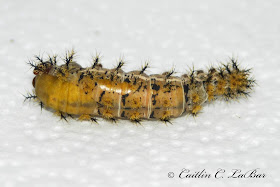Nevada Buckmoth (
Hemileuca nevadensis) is a striking day-flying moth found in riparian habitats ranging across much of the arid lands of the western United States and into the upper Midwest. See my earlier post on
Hemileuca species in the Pacific Northwest for other details about its life history. Although I have yet to see it in the wild, I obtained eggs from a breeder and reared them in 2010. I kept them in a cage indoors and fed them on willow cuttings. I cut larger branches that produced roots after a week or two of being kept in jugs of water, which helped maintain fresh food material for the larvae. I switched between cuttings of
Salix lasiandra (Pacific willow) and
S. fragilis (crack willow or brittle willow) and the larvae readily took to both throughout their growth.
The solid black first instar larvae look identical to other
Hemileuca species. Second instar (L2) is similar to
H. eglanterina, black with bright orange bristles. They begin to show a little yellow on their sides by the end of L2. The yellow increases in L3 and by L4 they are almost solid yellow with black markings, light orange/yellow and black bristles, and dark red-brown heads and legs. Adults are boldly marked in black and white with bits of reddish-orange hairs around their legs and thorax, and males have a reddish-orange-tipped abdomen.
 |
| Nevada Buckmoth (Hemileuca nevadensis) - hatching eggs |
Nevada Buckmoths lay their eggs in a ring around twigs. Larvae feed in together in clusters until the fourth instar when they start to spread out.
 |
| Nevada Buckmoth (Hemileuca nevadensis) - newly hatched larvae checking out some fresh willow. |
 |
| Nevada Buckmoth (Hemileuca nevadensis) - 1st instar larvae after a few days of feeding. |
 |
Caterpillars of Hemileuca species have urticating (stinging) hairs.
Paintbrushes are essential for moving them to fresh food unless you want to be stung! |
 |
| Nevada Buckmoth (Hemileuca nevadensis) - 2nd instar, on the march looking for more food. |
 |
| Nevada Buckmoth (Hemileuca nevadensis) - newly molted into 3rd instar. |
 |
| Nevada Buckmoth (Hemileuca nevadensis) - late 3rd instar larvae. |
 |
| Nevada Buckmoth (Hemileuca nevadensis) - newly molted 4th instar larvae. |
 |
| Nevada Buckmoth (Hemileuca nevadensis) - 4th instar larvae. |
 |
| Nevada Buckmoth (Hemileuca nevadensis) - early 5th instar larva. |
 |
| Nevada Buckmoth (Hemileuca nevadensis) - 5th instar larvae. |
 |
| Nevada Buckmoth (Hemileuca nevadensis) - 5th instar larva. |
 |
| Nevada Buckmoth (Hemileuca nevadensis) - prepupal larvae. |
 |
| Nevada Buckmoth (Hemileuca nevadensis) - pupa emerging from the larval skin. |
 |
| Nevada Buckmoth (Hemileuca nevadensis) - pupa emerging from the larval skin. |
 |
| Nevada Buckmoth (Hemileuca nevadensis) - pupa emerging from the larval skin. |
 |
| Nevada Buckmoth (Hemileuca nevadensis) - new pupa. |
 |
| Nevada Buckmoth (Hemileuca nevadensis) - pupa nearing time for adult to emerge: note the wing pattern showing. |
 |
| Nevada Buckmoth (Hemileuca nevadensis) - newly eclosed female. |
 |
| Nevada Buckmoth (Hemileuca nevadensis) - newly eclosed female. |
 |
| Nevada Buckmoth (Hemileuca nevadensis) - female. |
 |
| Nevada Buckmoth (Hemileuca nevadensis) - male. |
 |
| Nevada Buckmoth (Hemileuca nevadensis) - male. |
 |
| Nevada Buckmoth (Hemileuca nevadensis) - male "playing dead". |
Buckmoth/sheepmoth (
Hemileuca spp.) adults have an interesting defense mechanism: when they feel threatened, such as if they are suddenly grabbed or jostled, they fold their wings back, curl their body and drop to the ground, laying motionless for up to several minutes before becoming active again and crawling or flying up to a new branch.

























No comments:
Post a Comment